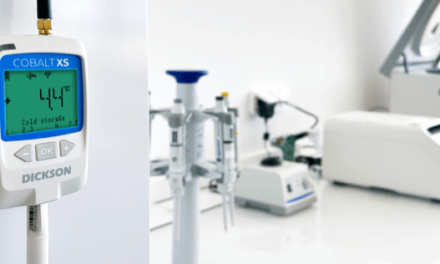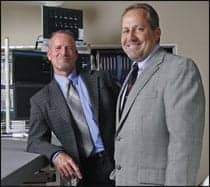 |
| L-R: Mike Fuller, CBET, operations manager, biomedical engineering; and Mike Braden, CBET, director of biomedical engineering/telecommunications. |
Financial flexibility is in short supply at most biomedical/clinical engineering departments. Without the freedom to allocate dollars where they are needed most, division heads often toil within their own silos, making financial decisions based on narrowly defined budget constraints. The folks at Orlando Health, Orlando, Fla, operated under this familiar model until about 6 years ago when they opted to take a different approach.
In what may be deemed a growing trend, managers at the six-hospital, 1,694-bed system decided to rethink how they finance their in-house department. Marrying the best aspects of independent service organizations (ISOs) with a philosophy not unlike an insurance company, officials transformed the nonprofit health network’s biomed department into a model of financial stability.
When Mike Braden, CBET, director of biomedical engineering/telecommunications, Orlando Health, arrived to guide the biomedical division, each hospital department had its own money for service contracts and repair costs. In the typical use-it-or-lose-it scenario, departments redirected unspent funds to areas that were not always the most efficient.
Along with Mike Fuller, CBET, operations manager, biomedical engineering, Braden brought together finance executives, clinicians, and biomedical equipment technicians—eventually pulling all the support dollars, service contract costs, and repair costs into the biomed department. Taking a cue from ISO contracts, Braden now gets more budget dollars when inventory is added. “Outside companies put a price tag on every piece of equipment, and if equipment is added, costs go up,” Braden says. “This year Mike [Fuller] and I worked with all of our CFOs across all the hospitals. Now, for all 37,000 pieces of equipment there is a cost per year on those devices.”
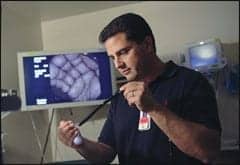 |
| David Carroll, biomedical equipment specialist, rigid/flexible scopes, Orlando Health, Orlando, Fla, inspects a flexible endoscope. |
“The new billing process has been very interesting to see unfold,” Fuller says. “Not only do our equipment owners get to see how much they pay for basic biomed support, they also get to see what items are under service contracts and how much they are paying for those specialized services. They also have access to an itemized list of equipment in their areas. Now that they are getting billed per equipment item, we are seeing a greater level of interest in their inventories. We have been able to remove equipment items that they no longer need along with a number of expensive contracts. The clinicians are helping us reduce support costs for the organization as well as assisting us with maintaining an accurate inventory.”
Orlando Health CFOs can now essentially see what it costs to have each device in the organization. As inventory is increased or decreased every quarter, Braden and Fuller adjust costs either higher or lower. “This mirrors what the outside service companies do,” Braden explains, who brings years of previous ISO experience to his role. “It now gives feedback to the CFOs on the actual costs of adding inventory, but they can also see how we are supporting it at a much lower cost than full service contracts. As CFOs add inventory throughout the year, our budgets are adjusted to compensate for that additional workload.”
Within reason, that money can now be used for whatever is deemed best for the hospital’s equipment needs. Whether it is full-time employees or repair costs, there is no more need to cajole management into providing additional funds.
“By having everything in one department, we are basically spreading our risk over 37,000 pieces of equipment, not just a few,” Braden explains. “So, even though we may take an expensive hit on one equipment or sector, we have a bunch of other ones that probably had a good month. Just like an insurance company wants to spread risk across its whole coverage area, we are spreading our risk of high repair costs over 37,000, not just a few.”
If Braden and Fuller want to train an employee on a particular piece of equipment, they have that option thanks to the inherent flexibility of managing dollars across a wide spectrum. The money is not locked up in a service contract, because they can decide to take their funds and drop the contract.
Working with the pool of money, they can take a financial hit in one area because savings are likely to be found in other areas. “When you put your support dollars all in one bucket, you don’t manage in little silos,” Braden says. “It’s difficult for a department that may have $10,000 for repairs. They don’t want to take a risk because they know that with one repair, they will blow their budget and have to answer to the CFO. We can afford to take a hit now and then.”
Pay to Stay
While Braden and Fuller are big believers in the value of well-trained in-house departments, they use OEM contracts and ISO services where appropriate. For example, Orlando Health has a multivendor agreement for imaging equipment, and ISO service contracts are routinely started and/or dropped on a case-by-case basis. OEMs, ISOs, training in-house staff, or time and material setups for some entities are all in the mix.
If Braden and Fuller decide to reduce the hours or levels of coverage for a particular equipment sector, they make it a point to consult the clinicians who use the equipment before making any final decision. Typically, hospital administrators quickly realize that OEMs cost a lot, so they agree on an ISO contract for 100% of their business. However, when hospitals send their equipment to these ISOs, they find that the ISOs might not be qualified to do the work. “Hospitals end up dropping the contract and going back to the OEM,” Braden says. “We say that we are not going to go with just one company for third-party repairs. We are going to find the right companies that have the skills to do high-level repairs. Our specialists determine whether jobs can be done by ISOs or whether they need to go to the OEMs.”
 |
| Mike Fuller (standing), and Mike Braden analyze program metrics. |
When Braden refers to “our specialists,” he is acknowledging a subset of biomedical technicians at Orlando Health that not only repair equipment, but also decide when it is best to let others do the repair. David Carroll is a biomedical equipment specialist, rigid/flexible scopes at Orlando Health who specializes in rigid and flexible scopes for arthroscopic and endoscopic procedures. Scopes are in heavy demand among surgeons and are notorious for high repair costs, particularly when OEMs are involved.
Carroll does few actual repairs, but instead monitors repair exchanges, oversees billing, and selects the crucial ISOs that will perform the troubleshooting. “Cases involving scopes are now scheduled in 30-minute intervals,” Carroll says. “If equipment goes down, surgeons still have a full load for the day. The longer that equipment is down, the slower their day gets and the more frustration that builds. Getting a quick first response and getting scopes back up helps the team get the job done in a timely manner.”
“David manages the program and looks at what repairs are needed, he assesses it, and finds quality third-party repair companies that are fully capable of performing a quality and reasonable repair,” Fuller says. “We don’t just send it back to the OEM. The ISO vendors know that they have to perform a quality repair, because if they do not meet our quality standards, David will stop using them. Our vendors do a good job of giving us high quality at a fraction of the cost of the OEMs.”
Carroll monitors the ISOs for costly annoyances such as duplicate billing. If a scope generates a bad image, and that equipment shows the same problem 3 weeks later, Carroll’s watchful eye prevents the company from charging Orlando Health for a duplicate repair. According to Braden, this ultimately saves the company “tons of money” just through this diligent monitoring.
If an OEM or ISO ends up appreciating Carroll’s knowledge and dedication, they may try to hire him away, an all-too-common problem in the biomedical world. Braden and Fuller have thought of this, and their anti-poacher mentality is reflected in a higher pay scale for specialists. “When you send a person to a high-end school, that person becomes valuable to other companies,” Fuller says. “A higher tier of pay for people who have special skills helps with retention. There could be a point down the road where a person in a specialty role could actually be paid more than the manager, because they have those skills that are in demand.”
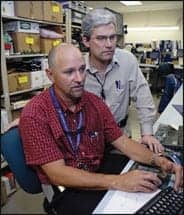 |
| L-R: Jeff Zalabak, electronics tech III, and Yevgeniy Postrekhin, BS, MS, electronics tech I, in a training session on reviewing event logs for the networked nurse call system. |
As with finding the right mix of third-party contracts and in-house personnel, the pay scale is all about balance. Going too far above market rate does not make sense, but it has to be just enough to ward off the vultures. Along with a scope specialist, Orlando Health’s expanded pay scale applies to specialists for laboratory devices and sterilizers. Boosting pay for these individuals meant taking the case to HR and explaining that the large hospital training investment would all be wasted if opportunistic third parties went after hospital employees.
Some of that expensive training is now used to maintain and update the skills of a specialist for high-end laboratory repair, an area where many biomed departments are content to outsource. At Orlando Health, laboratory technicians have become yet another example of the efficiency of in-house personnel. “Other department heads are now coming to us and asking if we can do even more in-house, because it has gone so well with our laboratory specialist,” Fuller says. “We actually at times have to say we can’t. And sometimes we say it makes sense to leave this the way it is depending on the support needs. The department requests are a testimony to the talents of our specialists and the entire biomed staff at Orlando Health.”
A biomed/IT liaison (also considered a specialist) oversees the vital integration between computer systems and medical equipment. Attesting to the importance of this role, the Association for the Advancement of Medical Instrumentation, the American College of Clinical Engineering, and the Healthcare Information and Management Systems Society agreed last year to combine resources and share best practices. The resulting CE-IT (clinical engineering/IT) community is now in the process of identifying issues and forming conclusions.
At Orlando Health, it’s the job of Brian Murphy, CBET, biomedical equipment specialist/IT liaison, to remain ahead of the curve and deal with the myriad issues of today’s connected medical equipment. “Orlando Health has been renovating several of our facilities, resulting in changes to some of our IT networks,” Murphy says. “I work with our IT team and vendors to help make sure that we get everything set up properly. “If networked medical equipment has issues, I’ll work with IT so we can get the equipment up and running as soon as possible.”
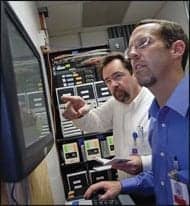 |
| L-R: Bill Turner, biomed tech I, and Brian Murphy, CBET, biomedical equipment specialist/IT liaison, troubleshoot a networked patient monitoring system. |
Once again, a dedicated individual saves the Orlando Health system time, money, and countless headaches. “If IT needs to do maintenance, they contact biomed Brian to see what devices may be impacted,” Fuller says. “Our talented IT department knows you can’t just go flipping off equipment. One of the facilities changed all of their IP addresses in conjunction with a new expansion. Brian assisted the IT team in looking at each networked medical equipment device on the network to match their new numbering scheme—a potential nightmare if not properly managed. We did not have a problem, and everything kept talking. Brian speaks our language and the IT language.”
The overall focus on cooperation has ultimately led to a culture that tends to head off problems before they happen. In an effort to integrate communication efforts, Braden and Fuller now report to the chief information officer and the biomed department now falls under the larger umbrella of the IT chief. Braden routinely meets with the IT directors to make sure plans are in synch, a relationship he says has worked well for all concerned.
Freedom and Flexibility
At Orlando Health, flexibility means that directors are not bound to an all-or-nothing system. Solutions are developed with patient care as the first consideration and financial sense as the logical next step. Fortunately, there is rarely tension between the two priorities.
In an economic climate where most biomeds are undeniably afraid of being outsourced, Orlando Health has managed to find a way to make the in-house model work. “With proper support from an organization, an in-house program can be a lot more effective than most third parties,” Braden says. “We work together with clinicians to make decisions. A lot of times with ISOs, the decisions are made by the outside company without really considering the impact on the clinical departments.”
If Braden and Fuller make a decision to drop a contract, they make sure the customer knows that if stat service is needed, they can pick up the phone, call the vendor, and get them in. “If the vendor is truly needed, get them in and I will work everything out later,” Braden says. “We meet with departments and stress that. A lot of times with an ISO agreement, it is mandated by contractual agreement that you have to call the ISO people first. If you don’t, their service will not be covered under their service contract. There is tension with ISOs, but with our program it is not an all or nothing. We look at areas where it makes sense to use an ISO, an OEM, or we do it with our own resources. And that’s what is different about our institution.”
For Carroll, Orlando Health’s different approach leads to a working environment that maximizes resources and minimizes frustration. “The system here is completely cohesive to what I do,” Carroll says. “Many people want to count pennies when hundreds of dollars are flying out the door. Since everything is pulled together here, one department may have a very expensive quarter, but the other seven departments may have had a light quarter. Eventually, it ends up balancing throughout the annual process.”
Greg Thompson is a contributing writer for 24×7. For more information, contact .
Apples to Elephants
Valid comparisons are often a touchy subject in the biomedical world. After all, biomeds often get roped into maintaining equipment that has little to do with their original job description. With a range of expertise among his biomedical engineering and electronics technicians, Mike Braden, CBET, director of biomedical engineering/telecommunications for Orlando Health, Orlando, Fla, makes sure his department gets credit for nontraditional tasks.
Along with Mike Fuller, CBET, operations manager, biomedical engineering, Braden oversees 10 electronics technicians and a host of biomedical techs within the six-hospital, 1,694-bed system. The electronics group is charged with maintaining equipment that is considered neither medical nor IT—items such as televisions, nurse call systems, video teleconferencing, security cameras, and security badge systems.
“We used our department to take over those gray areas and manage those as effectively as the other medical equipment,” Braden says. “It made sense for us to oversee it, but if you just looked at our department and you benchmarked us against other departments, we might seem to be large with high costs. But consider we are supporting a lot of other things.”
The task of benchmarking is no minor endeavor when you consider that bean counters are routinely looking for ways to cut costs. “We benchmark ourselves against other biomedical support companies to ensure that we can defend ourselves to the CFOs,” Braden says. “Biomedical departments must be able to show these things. Quality and patient care are job one, but we must also consider costs and be able to explain them. If you can prove how well you are performing, it takes a lot of heat off of you with the financial people.”
—GT



